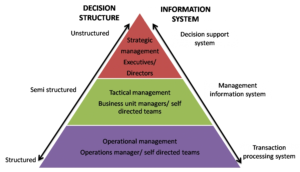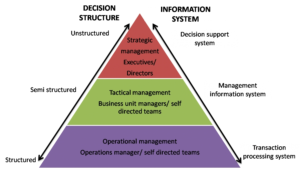Management > General Management > Functions of Management > Types of Plans
Classification of plans is done on the basis of what it seeks and the method in which it is applied.
Objectives or Goals:
The first step in the planning process is to set objectives. Objectives can be defined as the desired future position that the management would like to reach (end results). They are usually set by the top management of the organization and focus on broad, general issues. Objectives are a very basic level of planning. They serve as a guide for overall business planning. All other managerial activities are planned around these objectives. Different departments or units in the organization may have their own objectives. Objectives should be expressed in specific measurable quantitative terms, to be achieved in a specific period. They should be in a written form.

Strategic Plans:
Strategic planning begins with an organization’s mission. A strategy provides the broad contours of an organization’s business. These are the plans which act as a guideline to move the organization from where it currently is to where it wants to be. It is a comprehensive plan to make decisions defining the organization’s direction and scope in the long run to achieve the organizational objectives. Strategic plans look ahead over the next two, three, five, or even more years.
They are developed by top management after consulting the board of director and middle management. These are acted upon by all the departments, sections and individuals. For the success of these plans, there should be harmony and coordination at all level. It includes: i) determining long-term objectives, ii) adopting a particular course of action, and iii) allocating resources necessary to achieve the objective.
During strategy formation, the overall business environment should be considered. The business environment is influenced by economic, political, social, legal and technological factors. Hence thus during finalizing the strategy, these factors should be considered. Strategic plans involve decisions like whether the organization will continue to be in the same line of business, or combine new lines of activity with the existing business or seek to acquire a dominant position in the same market.
Tactical Plans:
Tactical plans are developed to support the implementation of strategic plans. These plans are developed by middle managers after consulting lower-level managers. They are more specific and concrete than strategic plans. The success of strategic and tactical plans depends upon the achievement of operational goals.
Operational Plans:
They are made for supporting the implementation of tactical plans and achievement of operational goals. They clearly specify the things needed to be done in the short run, in order to achieve the operational goals. They are developed by lower-level managers after consulting the middle managers. Their time period is less than one year, such as a few months, weeks or even days.
Standing Plans:
Standing plans are ongoing plans that aimed at providing guidance for performing recurring activities. The important types of standing plans are as follows
Policy:
A policy is a guideline that establishes parameters for making decisions. Policies are general statements that guide thinking or channelize energies towards a particular direction. They are guides to managerial action and decisions in the implementation of the strategy. The policy is not action but a parameter for action. There is a policy at all level and in all departments. Due to well-defined policy decision making becomes an easier task. It helps in resolving problems and issues easily.
The company may have a recruitment policy, pricing policy, refund policy, replacement policy within which objectives are set and decisions are made. The organization can have major policies regarding customers, clients, competitors etc. and minor policies which are adopted inside the organization in minute details. Managers duty is to interpret and implement the policy.
Procedures:
Procedures are routine steps on how to carry out activities to accomplish a particular task They give detailed guidelines for the exact manner in which any work is to be performed. Procedures are specified in a chronological and sequential order to be followed in particular circumstances. They are developed to use inside the organization. Policies and procedures are interlinked with each other. Procedures do not allow much flexibility or deviation, thus procedures give more specific actions than policies do.
Methods:
The procedure gives the sequence in which the task is to be accomplished while methods provide the prescribed ways or manner in which a task has to be performed considering the objective of the task. The Methods may vary from task to task. Selection of proper method is done such that it saves
time, money and effort and increases efficiency and productivity.
An appropriate method is selected for a specific task. For example, to impart training to employees at various level orientation programmes, lectures and seminars can be used for top-level management, job training methods and work-oriented methods for supervisory level and on the job training methods for workers.
Rule:
Rules are specific statements that inform what is to be done. Rules do not allow for any flexibility or discretion. i.e they do not allow any room for interpretation because it clearly specifies the actions needed to be done in a particular situation. They are the simplest form of plans. They are not compromised unless a policy decision is taken.
Single-Use Plans:
A single-use plan is a one-time plan specifically designed to achieve a particular goal that, once achieved, will most likely not recur in the future. Such a plan is developed to meet the needs of a unique situation. If it is accomplished, it will contribute to the long term success of the organization. There are two important types of single-use plans: programs and projects.
Programme:
Programmes are detailed statements about a project which outlines the objectives, policies, procedures, rules, tasks, human and physical resources required and the budget to implement any course of action. Programmes. In programmes minutest details like procedures, rules, budgets, are worked out within the broad policy framework.
Projects:
A project is a plan that organizes a set of limited-scope activities that do not need to be divided into several major parts in order to reach a significant nonrecurring goal.
Budget:
A budget is a statement of expected results expressed in numerical terms. This plan quantifies future facts and figures. For example, a
sales budget may forecast the sales of different products in each area for a particular month. Due to quantification, it becomes easier to
compare actual figures with expected figures and take corrective action thereon. Thus it is a control device, very important for the planning process.
Specific Plans:
Those plans which are clearly defined and leave no room for interpretation are called specific plans. Such plans require specific stated objectives and do not contain ambiguity.
Directional Plans:
Directional plans are the flexible plans that set out general guidelines. Such plans are preferable in a dynamic environment where management must be flexible in order to respond to unexpected changes.
Previous Topic: Significance of Planning

2 replies on “Types of Plans”
very detailed explanations
well articulated